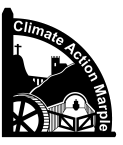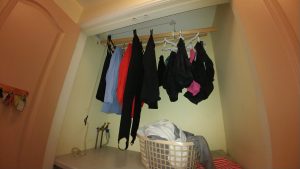

An opportunity to face the challenges that climate change will bring, and plan together as a community
Updated 21/4/23.
Marple has its own Eco House. It looks like an ordinary house in an ordinary street but underneath it all, things are not quite what they seem from the outside.
With the use of solar and thermal panels, wall and floor insulation, an air source heat pump and heat recovery ventilation this is a house full of good ideas for us all to learn from.
Follow these virtual tours to see all the ideas in this Eco House.
On the virtual tour pictures you will see some little i symbols which if you hover over will tell you what you are looking at. The numbers in the pop-ups refer to the numbered paragraphs which give a fuller explanation.
1. Solar hot water panels
2. Solar photovoltaic panels
3. Electric car charging point
4. External insulation
5. Rainwater collection system
6. Air source heat pump
7. Air extraction duct with flash arrester
8. Fresh air duct
9. Under floor insulation
10. Internal insulation
11. Thermostatic mixer tap
12. Mechanical Ventilation with Heat Recovery unit
13. Triple glazed windows
14. Air extraction duct
15. Clothes drying rack [see photograph]
The paragraph numbers refer to the hotspots on the virtual tours except for 15 which refers to a photograph below.
1. Hot Water. We have two Solar Thermal panels on the roof which heat the hot water. In the first winter we could not see much effect, but in our first summer, we had several weeks of totally free hot water. We have since added extra insulation to our large hot water cylinder so that it will stay hot for longer, so when the weather is variable, one good day will heat the water for at least two days.
2. Electricity supply. We have solar photovoltaic (PV) panels on the roof. The panels are rated at 3.7kWp and much of the year generate more electricity than we need, even though they are on a west facing roof. Much misinformation is give about the need for a south facing roof, but the loss to us is less than 20%. Unfortunately there are still some times of the day that there is a mismatch between our demand and supply but we are able to sell any surplus and buy any extra we need from the grid. We are also paid a “Feed in Tariff” for all the electricity we generate and this is used to pay both our gas and electricity bills averaged over the year and still leave us a small surplus. However, with the increase in energy prices in 2022, we now have to pay a small amount to cover the net cost our home energy.
3. We now run a fully electric car which has cut our fuel costs dramatically. Charging at home at night on economy 7, the car costs us about 5p per mile. While electric cars are more expensive to buy, they are much cheaper to run, including lower servicing costs.
4. The walls had cavity insulation but the rear of the house now has an additional layer of external insulation. This is comprised of 100mm extruded polystyrene foam insulation board bonded to a polystyrene vacuum formed skin to which are bonded 15mm thick fire clay brick slips. This has improved our energy efficiency by about 15%. The end wall is already very well insulated, but we had also intended to insulate the front of the house and cover up the non-matching brick of the extension. However, planning permission was refused on the grounds that it “would be an incongruous feature and adversely affect the street scene”. (But see no 10.)
5. To save water, we have two water butts and a rainwater diverter on the downpipe and this collects enough water for our garden during the summer.
6. We now have an Air Source Heat Pump installed to provide central heating and hot water in the winter. The unit is rated at 5kW but most of the time is using much less. Because our house is so well insulated, most of our radiators were large enough not to need uprating with the water in them heated to 45°C and the outside temperature at -2°C. Because heat pumps are more efficient when the radiator temperature is lower, the central heating is stopped for a short period while the hot water is heated. This is done at night during the economy 7 period. With a well insulated house you will not notice the loss of heat.
7, 8. These ducts bring in fresh air to the living areas of the house and remove stale air from the “wet” areas of the house, such as the kitchen, bathroom and toilet. It also removes damp air from the drying cupboard. (see also 14)
9. As part of leveling up the floors, 75cm of insulation was added and then covered with flooring grade chipboard.
10. Because we were not allowed to put external insulation on the outside of the front of the house, we had to add some on the inside. It would probably be allowed now but back in 2009, it was very unusual and the planning department were over-cautious. We had limited space inside so opted for 2cm of Aerogel insulation, a highly efficient thermal insulator, although also expensive. By striping back the walls to the brick before adding the insulation and covering it with plasterboard we lost less than one cm off the room.
11. If you heat your water using solar panels, a gas boiler, a heat pump, or even an immersion heater run off economy 7 electricity, using a thermostatic mixer tap is cheaper per shower than an electric shower.
12. Ventilation. Where possible, draughts have been eliminated and a mechanical ventilation system with heat recovery has been installed to keep the air fresh. This heats the fresh air coming into the house using heat from the stale air drawn out of the house. This system saves 90% of the heat normally lost by ventilation. Retrofitting a ventilation system require ducting to be installed but this does not need to be obtrusive.
13. Triple glazed windows are even better that doubled glazed windows and any new ones we installed were triple glazed.
14. See 7, 8 above.
 15. Tumble dryers use a lot of energy so we have installed a drying rack in a cupboard which is ventilated (the vent hiding in the top left corner). We only used the tumble dryer twice in the two years since we installed the drying rack, so we got rid of it. [SEE PICTURE] If you really do need a tumble dryer, get a heat pump type. Although they are more expensive, they will save you money on the running cost. In 2010, they were very expensive and difficult to find, but now most manufacturers make them.
15. Tumble dryers use a lot of energy so we have installed a drying rack in a cupboard which is ventilated (the vent hiding in the top left corner). We only used the tumble dryer twice in the two years since we installed the drying rack, so we got rid of it. [SEE PICTURE] If you really do need a tumble dryer, get a heat pump type. Although they are more expensive, they will save you money on the running cost. In 2010, they were very expensive and difficult to find, but now most manufacturers make them.
While you may not be able to do all of these things in your house, and we recognise we were very fortunate that we could, if you are thinking of changing anything such as building work, a new boiler, new lighting or even decorating, then now is the time to take another step towards a lower carbon home. Please email us if you want any more information or help to improve your carbon footprint.
Builder: Brian Cooper & Sons (Glossop) 01457 855 712 07930 899558
Solar PV: Smart Green Energy 01457 853 517 www.smartgreenenergycompany.com
Solar Thermal: GroundTherm 07796 811072 www.groundtherm.co.uk
Ventilation unit: Xpelair Xcell 150 QV 0844 372 7761 www.xpelair.co.uk
External Insulation: Eurobrick Systems Ltd. 0117 971 7117 www.eurobrick.co.uk
Heat pump: H2O Renewables Ltd. 07889 949 959 or 07840 975816 www.h2orenewables.co.uk
2023 Climate Action Marple All Rights Reserved Privacy Policy : Cookie Policy